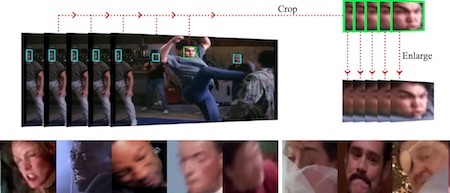Marc Abrahams's Blog, page 184
June 2, 2018
Recognizing wild faces, or maybe not [Celebrity-based research]
“Our experimental results demonstrate that state-of-the-art techniques are not well-suited for violent scenes,” says the study “Wildest Faces: Face Detection and Recognition in Violent Settings,” Mehmet Kerim Yucel, Yunus Can Bilge, Oguzhan Oguz, Nazli Ikizler-Cinbis, Pinar Duygulu, Ramazan Gokberk Cinbis, arXiv:1805.07566, 2018. The authors, at Hacettepe University and Middle East Technical University, Turkey, further explain:
“existing datasets do not capture the difficulty of face recognition in the wildest scenarios, such as hostile disputes or fights. Furthermore, existing datasets do not represent completely unconstrained cases of low resolution, high blur and large pose/occlusion variances. To this end, we introduce the Wildest Faces dataset, which focuses on such adverse effects through violent scenes. The dataset consists of an extensive set of violent scenes of celebrities from movies”

A look back at the remains of Oregon’s exploding whale, and Other Carcass Demolition
Reporters look back, more or less fondly, in this video, at the most famous exploding whale incident of the 20th century. As the video in this video shows, a dead whale washed up on a beach, and local authorities tried to dispose of the remains by using dynamite. The result was more fervent than they had anticipated:
(Thanks to Ben Henick for bringing this historic video to our attention.)
The disposal technique, with variations, has been used elsewhere, generally on smaller-than-a-whale-yet-still-pretty-large carcasses.
We have discussed, here, “How to blow up a cow (officially),” and also the story of “Deciding not to blow up a cow (officially).” Both of those discussions involve the US Forest Service’s standard procedure as specified in the document “Obliterating Animal Carcasses with Explosives,” by Jim Tour and Mike Knodel, 1995, USDA Forest Service document #9523-2315–MTDC. The document begins by showing how to proceed if there is no great urgency:
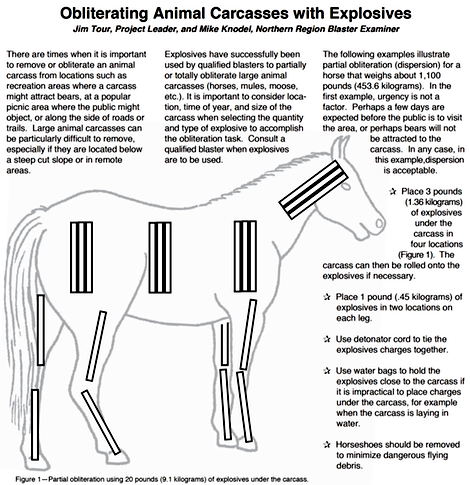
The document then shows how to place the dynamite if the problem must be dealt with quickly:
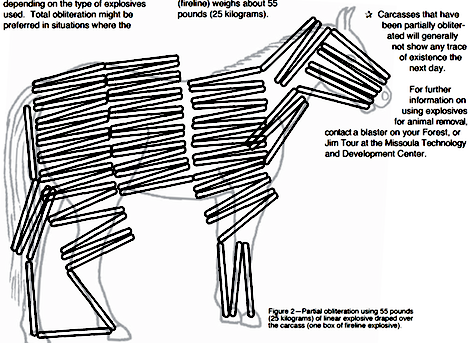
UPDATE (related): “Fire at London’s Hayward Gallery as Rotting Fish Artwork Explodes.” (Thanks to John Simmons and Sally Shelton for bringing this to our attention.)

A look back at the remains of Oregon’s exploding whale, and at cows
Reporters look back, more or less fondly, in this video, at the most famous exploding whale incident of the 20th century. As the video in this video shows, a dead whale washed up on a beach, and local authorities tried to dispose of the remains by using dynamite. The result was more fervent than they had anticipated:
(Thanks to Ben Henick for bringing this historic video to our attention.)
The disposal technique, with variations, has been used elsewhere, generally on smaller-than-a-whale-yet-still-pretty-large carcasses.
We have discussed, here, “How to blow up a cow (officially),” and also the story of “Deciding not to blow up a cow (officially).” Both of those discussions involve the US Forest Service’s standard procedure as specified in the document “Obliterating Animal Carcasses with Explosives,” by Jim Tour and Mike Knodel, 1995, USDA Forest Service document #9523-2315–MTDC. The document begins by showing how to proceed if there is no great urgency:

The document then shows how to place the dynamite if the problem must be dealt with quickly:


June 1, 2018
STILL MORE INFO: Dead Duck Day, June 5th, honoring homosexual necrophilia in the mallard
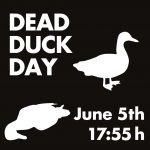 Tuesday, June 5th, 2018 is the 23rd edition of Dead Duck Day, arriving precisely one year after last year’s Dead Duck Day. At exactly 17:55 h [Rotterdam time] we will honor the mallard duck that became known to science as the first (documented) ‘victim’ of homosexual necrophilia in that species, and earned its discoverer the 2003 Ig Nobel Biology Prize.
Tuesday, June 5th, 2018 is the 23rd edition of Dead Duck Day, arriving precisely one year after last year’s Dead Duck Day. At exactly 17:55 h [Rotterdam time] we will honor the mallard duck that became known to science as the first (documented) ‘victim’ of homosexual necrophilia in that species, and earned its discoverer the 2003 Ig Nobel Biology Prize.
We presented some info about this yesterday. Here are further details.
Dead Duck Day also commemorates the billions of other birds that die from colliding with glass buildings, and challenges people to find solutions to this global problem.
Please join the free, short open-air ceremony next to the new wing of the Natural History Museum Rotterdam (the Netherlands), right below the new Dead Duck Memorial Plaque — the very spot where that duck (now museum specimen NMR 9989-00232) met his dramatic end.
This is what will happen:
The traditional Ten Seconds of Silence.
Review of this year’s necrophilia news, with (1) applause for Harshil Patel, Pranav Vaghashiya, and Shantilal K. Tank for publishing their paper ‘Necrophiliac Behavior in the Common Asian Toad, Duttaphrynus melanostictus (Schneider 1799) in Western India‘ and (2) the first public appearance of dead duck specimen NMR 9989-05220 a new victim of heterosexual necrophilia in the mallard.

The official announcement of ‘Der Entenmann‘ – the long-awaited German edition of ‘De eendenman‘ [The Duck Guy].
The reading of the special ‘Dead Duck Day Message’. This years message, a dead duck story, send in by Eva Menasse, author of amongst others the novel ‘Tiere für Fortgeschrittene‘ [Animals for the Advanced] will be read by Kim Zieschang.
Presentation of an addition to the Dead Duck Day Fashion Line, designed by Mark Prinsen.
A six-course duck dinner, after the ceremony. The traditional six-course (dead) duck dinner at the famous Tai Wu Restaurant is also open to the public (at your own expense). Reserve your seat by e-mailing to: info [at] hetnatuurhistorisch.nl


May 31, 2018
A look back at the Penises of the Animal Kingdom poster
Colin Dickey, writing in Topic magazine, explores the history of the Ig Nobel Prize-winning poster “Penises of the Animal Kingdom” and its creator, Jim Knowlton. Dickey’s report bears the headline “The Penis Poster That Rubbed People the Wrong Way“:
“… Knowlton had been a graduate student at Columbia University, working on a PhD in particle physics, when he first concocted the idea for the poster. A colleague’s comment about how snakes have two penises, he later recalled, got him “thinking about penis trivia,” which soon “moved into the further realm of comparing.” He was 24 years old when he began selling the poster in 1985; after he completed his master’s, his academic funding was cut off. He moved out to Indiana, he later told a reporter, to continue selling his poster and start a rock band. The poster business was a one-man operation, and by then, Knowlton estimated, he was selling about 5,000 copies a year.
“In 1992, the poster’s notoriety earned it an Ig Nobel Prize—a set of parodic counterparts to the Nobel Prizes that are awarded each year by Marc Abrahams, editor of the science-humor magazine the Annals of Improbable Research. “The prizes are not intended to say that anything is bad or good,” Abrahams says. Instead, the sole criterion is: “Does it make people laugh and then think?” Few laureates have made work that has fit these criteria as well as Knowlton’s poster does….”

‘My Direct Brain Stimulator has been struck by lightning’ (case report)
 Nowadays, many patients with neurological problems are fitted with Direct Brain Stimulation (DBS) devices such as Implantable Pulse Generators (IPGs). However, like any electronic devices, they can be adversely affected by strong electrical and electromagnetic fields. A recent case was brought to light in the Journal of Neurosurgery, describing the plight of a 66-year-old woman who had been fitted with a bilateral globus pallidus internus DBS implant :
Nowadays, many patients with neurological problems are fitted with Direct Brain Stimulation (DBS) devices such as Implantable Pulse Generators (IPGs). However, like any electronic devices, they can be adversely affected by strong electrical and electromagnetic fields. A recent case was brought to light in the Journal of Neurosurgery, describing the plight of a 66-year-old woman who had been fitted with a bilateral globus pallidus internus DBS implant :
“The electrical installation of her apartment was struck by lightning during a thunderstorm. Electrical devices (a television and air conditioner) operating in the apartment at that time were burned and destroyed. The patient was not charging the battery of her IPG during the event, and the recharger for the IPG was disconnected from the power supply during the storm. The recharger and IPG were therefore not destroyed. The patient realized that something was wrong only 1 hour after the storm subsided, when the dystonic tremor in her neck reappeared. When she checked the function of her IPG, the POR (Power On Reset) warning appeared on her patient programmer’s display. The patient was afraid that her IPG was damaged and came to the outpatient clinic for assistance.”
Fortunately, an examination showed that all was well with the patient and her device, which was reset, and then continued to function normally. The authors of the paper therefore advise :
“Patients should be regularly warned to avoid environmental sources that generate strong EMFs, such as arc welding equipment, electronic power generators, electrical substations, ham radio antennas, power lines, microwave communication transmitters, industrial furnaces, induction heaters, resistance welders, and transmission towers for television and radio signals.”
See: Lightning may pose a danger to patients receiving deep brain stimulation: case report J Neurosurg, May 1, 2018.

May 30, 2018
The Big Bank Opera resumes in real life
The New York Times reports, on May 30, 2018:
Big Banks to Get Reprieve from Volcker Rule
Big banks are getting a big reprieve from a post-crisis rule aimed at curbing risky behavior on Wall Street.
Federal bank regulators on Wednesday unveiled a sweeping plan to soften the Volcker Rule, opening the door for banks to resume some trading activities restricted as part of the 2010 Dodd-Frank law. The changes would give the largest banks significant freedom to engage in more complicated — and possibly riskier — activities…
This may be designed to allow American banks to resume more of the kinds of activities that were celebrated in “The Big Bank Opera.” That opera premiered as part of the 2009 Ig Nobel Prize ceremony. Here’s video of Act 3, which gives the entire history of money and banks in a single song. (The tune is “Una voce poco fa” from the older opera, “Barber of Seville,” by Gioachino Rossini. The words are 21st century.):
You can also, should you be greedy, watch Act 1, Act2, and the thrilling concluding act, Act 4.
This photo from the opera’s premiere, shot by David Holzman, shows soprano Maria Ferrante in Act 3:

(SUMMARY OF THE OPERA’S PLOT: Swanky bankers celebrate themselves, the history of money, and the out-of-this-world rise of big banks. The big banks crash to earth. The bankers vituperate, with swank.)

Official program for the 2018 Dead Duck Day celebration (June 5)
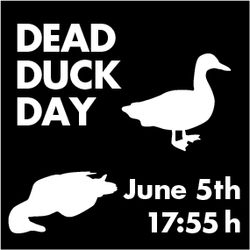 Read, if you will, the official program [in Dutch] for this year’s Dead Duck Day celebration—which will happen June 5, at the Natural History Museum in Rotterdam, The Netherlands.
Read, if you will, the official program [in Dutch] for this year’s Dead Duck Day celebration—which will happen June 5, at the Natural History Museum in Rotterdam, The Netherlands.
Dead Duck Day honors the mallard duck that became known to science as the first (documented) ‘victim’ of homosexual necrophilia in that species. The study that documents the incident was itself honored, along with its author, with the 2003 Ig Nobel Prize for biology.
Here’s video of Kees Moeliker, who witnessed the original incident, and later wrote that scientific study, telling all about it in a TED Talk:
BONUS: Everyone who attends the Dead Duck Day celebration is invited to also join Kees Moeliker, immediately after the ceremony, for the traditional short walk to a nearby Chinese restaurant for a delicious six-course duck dinner.

Maps of the Many, Many Roads to Heaven and Hell
“There are many woodcuts and broadsides depicting the roads to heaven and hell,” says the Graphic Arts Collection blog, from its cozy home at Princeton University’s Firestone Library. The blog shows and discusses several maps of “The Many, Many Roads to Heaven and Hell.”
(Thanks to John Overholt for bringing this to our attention.)
BONUS (possibly related): “Rat brain ‘GPS’ maps routes to rewards“

The benefits, to non-scientists, of DNA research: Lennon’s Tooth
Molecular biology research, once seen as exotic, now showers benefits on the population at large. The May 29, 2018 issue of The Irish Sun brings news of the newest benefit:
HERE COMES THE SON Dentist who owns John Lennon’s tooth will use DNA test to find Beatle’s potential love children in bid to claim slice of his £400m estate
Dr Michael Zuk, from Alberta, Canada, purchased the famous body part at auction in 2011 for £20,000
 Thanks to Vaughn Tan for bringing this to our attention.)
Thanks to Vaughn Tan for bringing this to our attention.)
BONUS (not related): Lenin’s tomb

Marc Abrahams's Blog
- Marc Abrahams's profile
- 14 followers


